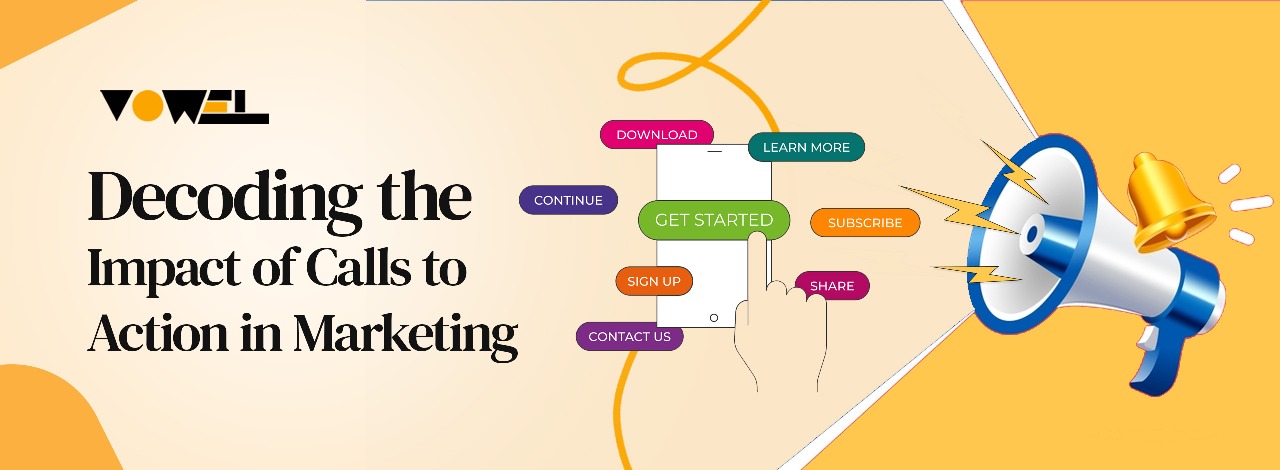

Decoding the Impact of Calls to Action in Marketing
In today's fast-paced digital world, capturing the attention of your audience is only half the battle. The real challenge lies in driving them toward a desired action. This is where Calls to Action (CTAs) play a pivotal role in marketing strategies. Whether it's encouraging a user to sign up for a newsletter, download a guide, or make a purchase, the right CTA can be the difference between a casual visitor and a committed customer.
In this blog, we'll dive deep into the impact of Calls to Action in marketing. We'll break down what makes a CTA effective, explore different types of CTAs, and offer insights into how brands can optimize their marketing messages for better conversion rates.

What is a Call to Action (CTA)?
A Call to Action is a prompt in marketing content that instructs the audience to perform a specific action. It is usually presented as a button, hyperlink, or textual directive such as "Buy Now," "Download Free Guide," "Subscribe Today," or "Learn More."
The goal of a CTA is to guide the user journey, providing a clear path forward from awareness to consideration to conversion.
Why CTAs Are Crucial in Marketing
CTAs are not just decorative additions to marketing copy---they are essential for converting engagement into results. Here's why they matter:
1. Guide User Behavior
CTAs provide direction. When a visitor lands on a website, a well-crafted CTA tells them what to do next, reducing hesitation and enhancing user experience.
2. Improve Conversion Rates
Whether it's a landing page, an email, or a blog post, including a compelling CTA can significantly boost your conversion rate by encouraging users to take meaningful actions.
3. Measure Campaign Effectiveness
By tracking CTA clicks, marketers can evaluate which content or messaging is performing best and adjust accordingly for improved ROI.
Types of CTAs in Marketing
Understanding the different types of CTAs helps tailor them to specific stages of the customer journey. Here are the most common types:
1. Lead Generation CTAs
These are designed to collect contact information, often by offering something of value like an eBook or a webinar.
- Example: "Download Your Free Guide"
2. Form Submission CTAs
Once a lead form is filled, a CTA like "Submit" or "Sign Me Up" finalizes the interaction.
3. Read More CTAs
Used in blogs or content hubs to increase on-site engagement by encouraging readers to explore more content.
4. Product Discovery CTAs
Help users discover or explore more about a product or service.
- Example: "View Features" or "See Plans"
5. Sales CTAs
Directly prompt users to make a purchase or complete a transaction.
- Example: "Add to Cart" or "Buy Now"

Characteristics of an Effective CTA
A CTA isn't just about flashy buttons or bold text. To be effective, it needs to embody several important characteristics:
1. Clarity
Your CTA should be straightforward. Avoid jargon and make sure the user understands exactly what will happen when they click.
- Bad: "Submit"
- Good: "Get My Free eBook"
2. Action-Oriented Language
Use strong verbs that encourage action. Words like "Download," "Start," "Get," "Join," and "Learn" prompt the user to move forward.
3. Urgency
Creating a sense of urgency can boost conversions.
- Example: "Limited Time Offer -- Buy Now"
4. Value Proposition
The CTA should clearly communicate what the user will gain.
- Example: "Unlock 30% Discount Instantly"
5. Design and Placement
Color, size, and positioning matter. Make sure your CTA stands out without being intrusive.
CTA Placement: Where You Put It Matters
Even the most compelling CTA can underperform if it's in the wrong place. Strategic placement is key to maximizing visibility and clicks.
1. Above the Fold
Placing CTAs at the top of a page ensures users see it without scrolling.
2. End of Content
After users engage with your content, they're more likely to take the next step.
3. Pop-Ups and Slide-ins
These dynamic elements can grab attention effectively if used sparingly and not disruptively.

A/B Testing for CTAs
A/B testing is crucial in understanding what resonates best with your audience. You can test:
- Button color
- Text variations
- Placement on the page
- Font size and style
Even minor tweaks can result in significant improvements in click-through rates and conversions.
Example:
- Version A: "Start Your Free Trial"
- Version B: "Try It Free for 7 Days"
Testing these variations helps marketers optimize for better performance.
CTAs Across Different Marketing Channels
1. Email Marketing
CTAs in emails should be prominent and action-driven, like "Claim Your Offer" or "RSVP Now."
2. Social Media
Short, punchy CTAs like "Tap to Shop" or "Tag a Friend" work well.
3. Landing Pages
Since these pages are designed for conversion, a strong CTA is the centerpiece---"Get Started," "Join Now," or "Sign Up Free."
4. Blogs
Subtle but effective CTAs like "Continue Reading" or "Download Our Checklist" can help guide engaged readers to deeper funnel actions.
Mistakes to Avoid with CTAs
1. Being Too Vague
"Click Here" lacks context. Always be specific about what the user will get.
2. Overloading with CTAs
Too many CTAs on one page can confuse and overwhelm the user.
3. Ignoring Mobile Optimization
Your CTA should be easily tappable and visible on mobile screens.
4. Poor Visual Design
A bland or poorly placed CTA can easily get ignored, even if the copy is perfect.
Final Thoughts: CTAs Are Small But Mighty
The impact of CTAs in marketing cannot be overstated. They bridge the gap between content consumption and user action. A compelling, well-placed, and properly tested CTA can boost engagement, improve conversions, and drive real business results.
As marketing becomes increasingly data-driven and user-focused, CTAs will continue to be the linchpin that turns interest into intent and browsers into buyers. Whether you're a seasoned marketer or just starting out, refining your CTAs could be the easiest way to elevate your entire marketing strategy.

Frequently Asked Questions
What is a Call to Action (CTA) in marketing?
A CTA is a prompt that encourages users to take a specific action, such as "Buy Now," "Sign Up," or "Learn More."
Why are CTAs important in marketing campaigns?
CTAs guide user behavior and help increase conversions by clearly showing what the next step should be.
Where should I place a CTA for the best results?
Effective placements include above the fold, at the end of content, in pop-ups, or within emails and landing pages.
What makes a CTA effective?
A great CTA is clear, action-oriented, visually distinct, and offers value to the user.
How can I test which CTA works best?
Use A/B testing to compare different versions of your CTA text, design, or placement to see which performs better.

